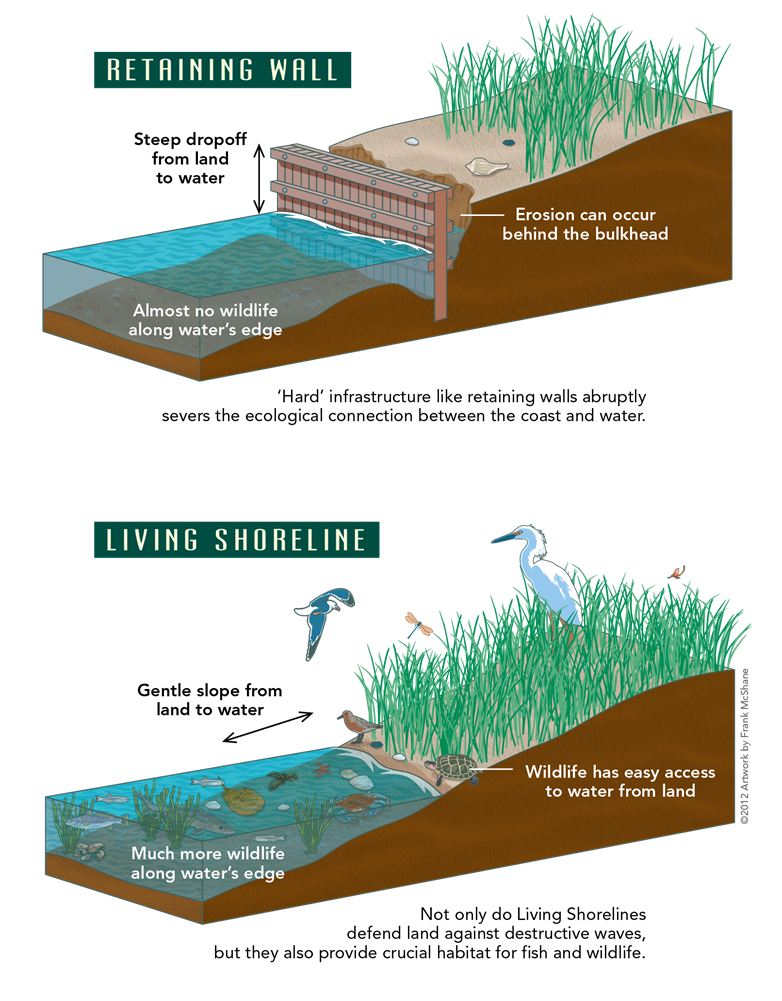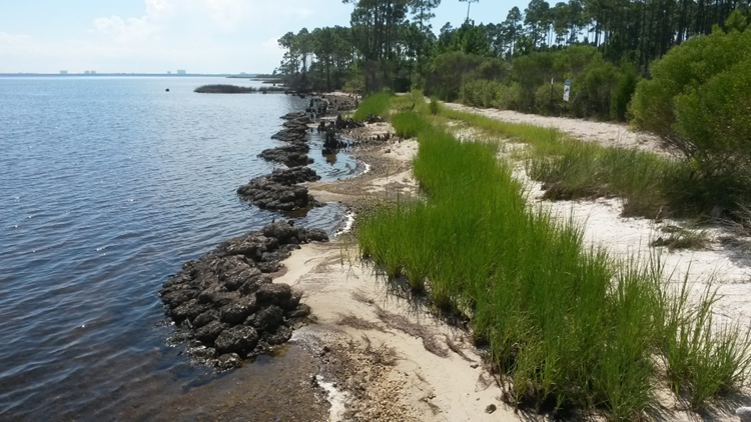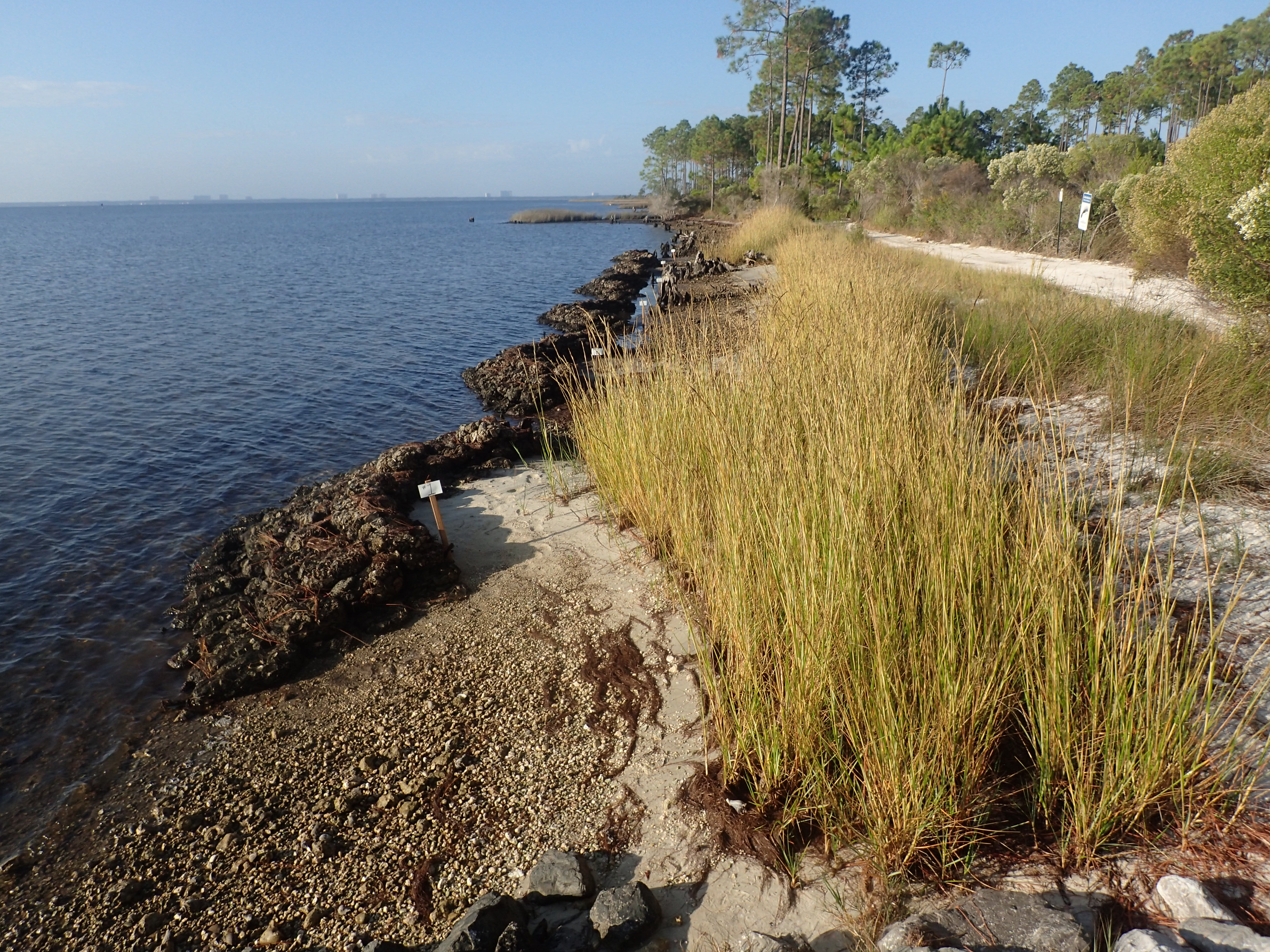Living Shorelines
Get involved! Contact us today!
“Protecting vital sources of renewal – unscathed marshes, healthy reefs, and deep-sea gardens – will provide hope for the future of the Gulf, and for all of us.” Sylvia Earle
What is a “Living Shoreline“?
“A shoreline management practice that provides erosion control benefits; protects, restores, or enhances natural shoreline habitat; and maintains coastal processes through the strategic placement of plants, stone, sand fill, and other structural organic materials (e.g. biologs, oyster reefs, etc).” – National Oceanic and Atmospheric Administration
How does a living shoreline work?
Like a hardened structure, living shorelines can provide shoreline stabilization in places where a shoreline is eroding. However, unlike hardened structures, living shorelines provide many other benefits for humans, plants, and animals besides shoreline stabilization, including cleaning water, improving habitat for animals, fish, and birds, and providing enjoyable aesthetics for property owners. Living shoreline projects utilize a variety of materials such as native coastal salt marsh plants, recycled oyster shell, coir fiber logs, sand, wood, and/or native rock.

Living shorelines work by mimicking natural conditions and can change or adapt to the conditions around them making them a sustainable option for shoreline management thus creating a “softer and greener” alternative to hardened seawalls. ‘Hard’ infrastructures or “gray” approaches, such as bulkheads or retaining walls, cannot change or move depending on the season, weather or other conditions, and often result in scouring, structural damage and even shoreline erosion downstream.
What are the benefits of Living Shorelines?
- Promote environmentally-friendly shoreline stabilization techniques to benefit all coastal estuarine species. Native coastal salt marsh vegetation and oyster reefs provide foraging, nursery and resting areas for juvenile and adult Gulf sturgeon, saltmarsh topminnow, Kemp’s riley sea turtle, Florida manatee, and many migratory and wintering birds.
- Promote establishment of Best Management Practices (BMPs) to influence greener policy to address shoreline erosion using native vegetation for nature-based stabilization solutions for shoreline protection instead of hardened seawalls.
- Planting of shoreline vegetation aids in the uptake of nutrients and/or pollutants from runoff thus preventing these components from entering the waterbody thereby contributing to improved water quality. Additionally, natural shoreline vegetation shades water discouraging the growth of algae.
- The root systems of vegetation help stabilize the soil along a shoreline protecting it from waves and soil erosion; providing stabilized area for the natural re-establishment of higher elevation saltmarsh, coastal upland plant species, and seagrasses.
- Oysters recruitment on oyster reef breakwater structures increase water quality and reduce turbidity, resulting in improved light penetration which will benefit the growth of seagrasses and other aquatic species.
- Increased recreational opportunities. Increased commercial and recreational fishing opportunities. Increased ecotourism i.e. nature watching, canoeing and kayaking.
- Increased outreach and environmental education experiences for GIC students. Andrew Bay Grasses in Classes lessons support student development of critical thinking skills and provides an introduction to environmental stewardship and community citizenship. Students are involved in addressing “real life” issues as they arise during the project.
In contrast to hardened shorelines, which become weaker over time, a living shoreline gets better with age as it grows stronger and more resilient. A living shoreline is not only an investment in the environment, it is also an investment in your home and quality of life.
What are the steps to create a living shoreline and how long will it take?
For living shoreline projects, Bay Watch completes and submits permitting applications on behalf of our clients. Sometimes the permitting process is the most lengthy process. This process can take from several weeks to a few months with the actual restoration only taking a few days. Here are the main steps involved in planning and implantation.
- Site analysis: The first step is to determine whether living shoreline stabilization is appropriate in a particular area. This analysis includes an evaluation of the bank erosion rate and elevation, wave energy, prevailing wind and wave direction, vegetation, and soil type. Design of restoration activity begins after the site analysis.
- Permit approval and legal compliance: Compliance with all federal, state, and local laws, regulations, and permits for proposed restoration activities must be ensured prior to implementation.
- Site preparation: This begins after appropriate permits are obtained from regulatory agencies. The site is cleared of debris and unstable trees, and failing seawalls and bulkheads can be removed. Any runoff issues should also be identified and addressed prior to material installation.
- Installation: Typical living shoreline treatments include planting riparian, marsh, and submerged aquatic vegetation; installing organic materials such as bio-logs and organic fiber mats; and constructing oyster reefs or “living breakwaters” that dissipate wave energy before it reaches the shore.
- Post-construction monitoring and maintenance: This includes scientific monitoring of restored habitat to gather information on the success of the project. Maintenance activities include debris removal, replanting vegetation, adding additional sand fill, and ensuring that the organic and structural materials remain in place and continue to stabilize the shoreline.

Do you have an eroded shoreline that you think is a good candidate for a living shoreline?
For more information or to volunteer, contact us:
call 850.763.4303 or email Program Director, Christina Cantrell
